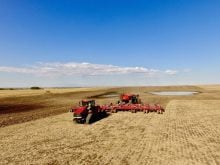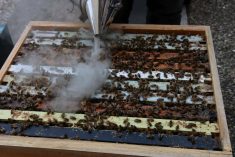Thanks to another week of relatively good conditions, 91 per cent of the crop is now in the ground. This is up from 70 per cent last week and remains well ahead of the five-year (2013-2017) seeding average of 81 per cent for this time of year.
The southwest region is the most advanced with 95 per cent of the crop seeded. Ninety-three per cent is seeded in the southeast, 92 per cent in the west-central region, 90 per cent in the northwest, 87 per cent in the northeast and 86 per cent in the east-central region.
Read Also

Claas brings 1000 Series SP forage harvesters to Canada
In mid-August, Claas unveiled its new line of Jaguar forage harvesters at an event in Visalia, California, deep in the heart of that state’s dairy region.
Ninety-eight per cent of the lentils, 94 per cent of the durum, 92 per cent of the spring wheat, 90 per cent of the soybeans, 88 per cent of the canola, 85 per cent of the barley and 84 per cent of the flax have now been seeded.
Scattered rain showers brought varying amounts of rain this past week, helping to temporarily alleviate concerns of dry field conditions. Rainfall ranged from trace amounts to 72 mm in the Humboldt area with many areas reporting about 25 mm or less. While significant rain is still needed in the majority of the province to help crops emerge and hay land and pasture establish, some areas in the northeast have excess moisture.
Topsoil moisture conditions have slightly improved with recent rainfall. Provincially, topsoil moisture conditions on crop land are rated as one per cent surplus, 51 per cent adequate, 36 per cent short and 12 per cent very short. Hay land and pasture topsoil moisture is rated as 38 per cent adequate, 44 per cent short and 18 per cent very short.
Overall, emerged crops are in poor-to-good condition, but emergence has been patchy and delayed by dry field conditions. The majority of crop damage this past week was caused by strong winds, lack of moisture and insects such as flea beetles and cutworms in canola. Localized hail was also reported in some areas.
Farmers are busy finishing up seeding, picking rocks and starting in-crop pesticide applications.
SaskPower says there were 15 reported cases of farm machinery contacting electrical equipment in the last week. That brings the total for May to 143. Most farm-related incidents happen during seeding. SaskPower reminds producers to be aware of their surroundings at all times and plan ahead. More safety information is available on the SaskPower Safety web page.














